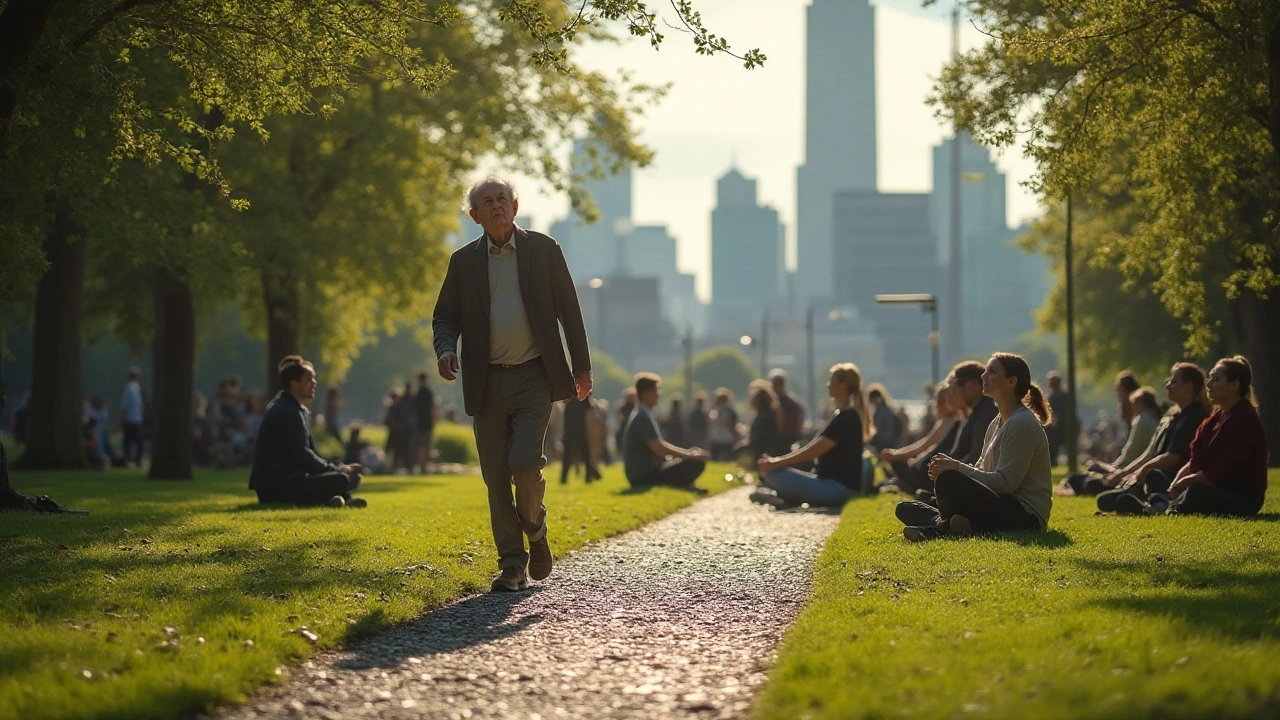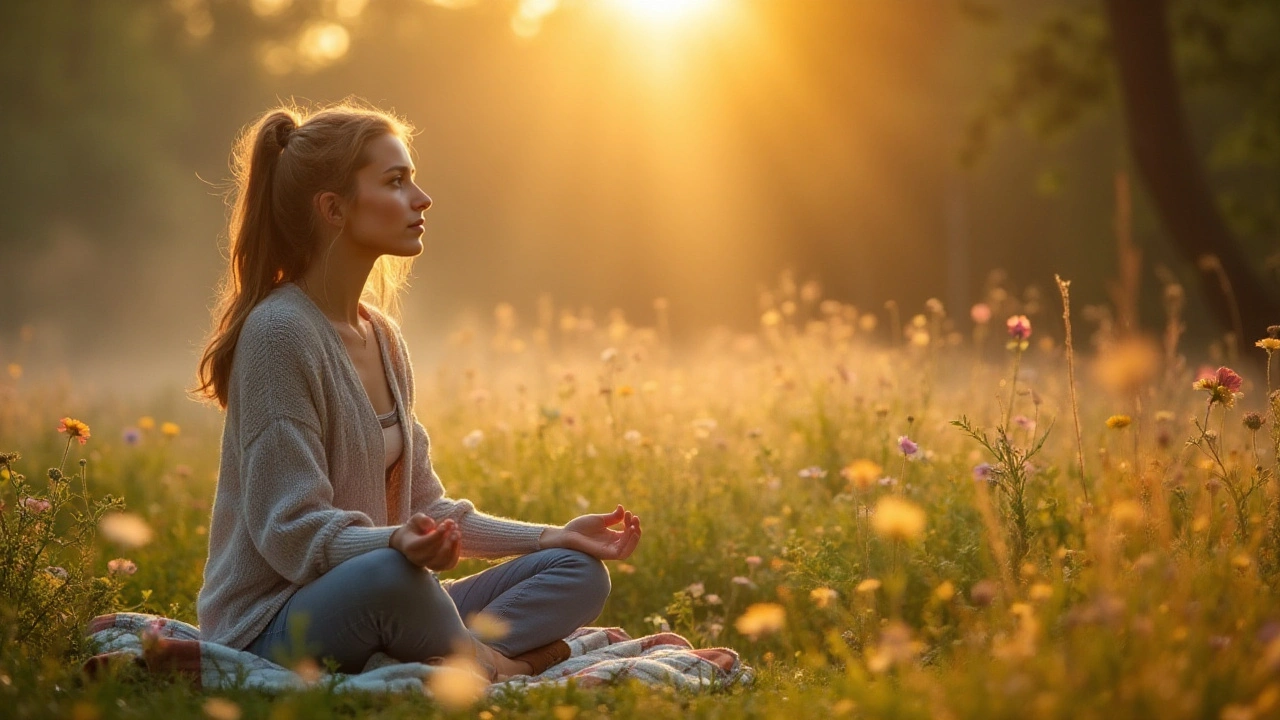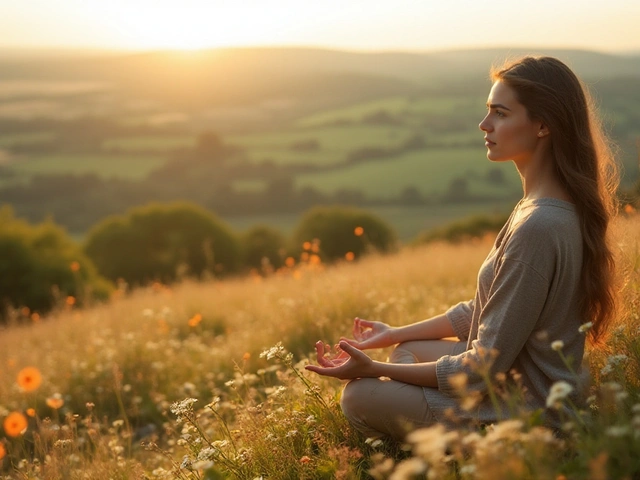Mindfulness—a term we often hear but seldom grasp—is about being fully present and aware of where we are and what we’re doing. In a world cluttered with distractions, diving into the art of mindfulness can seem daunting. Yet, at its core, it's surprisingly simple and incredibly rewarding.
As beginners, the journey to mindfulness doesn't have to be complicated or overwhelming. It's about weaving small, consistent habits into the tapestry of our everyday lives. The beauty of mindfulness lies in its accessibility; anyone can do it, anytime and anywhere.
Whether you're enjoying a cup of coffee in the early morning light or walking through a bustling city street, this practice invites you to find peace in the now. Allow this guide to be your companion as you explore the nurturing and transformative power of mindfulness.
- What is Mindfulness?
- Benefits of Practicing Mindfulness
- Getting Started with Mindfulness
- Mindfulness Techniques for Beginners
- Incorporating Mindfulness Into Daily Life
What is Mindfulness?
Mindfulness is a practice rooted in ancient traditions, yet it has increasingly gained attention in modern life due to its simple yet profound impact on our day-to-day living. At its essence, mindfulness is about being truly present in the moment, fully aware of where we are and what we're doing, without being overly reactive or overwhelmed by what's happening around us. The practice encourages us to pause, breathe, and take stock of our thoughts, emotions, and sensations with a gentle, non-judgmental attitude. This means letting go of regrets about the past and anxieties about the future, bringing our full attention to the current moment.
Mindfulness has its roots in Buddhist meditation practices, but in the past few decades, it has been adapted into a secular practice that anyone can benefit from, regardless of their spiritual beliefs. This shift was popularized by figures such as Jon Kabat-Zinn, who founded the Mindfulness-Based Stress Reduction (MBSR) program at the University of Massachusetts Medical Center. He described mindfulness as "paying attention in a particular way: on purpose, in the present moment, and nonjudgmentally." Since then, research has exploded into the health benefits of mindfulness, with numerous studies linking regular practice to reduced stress, improved focus, and greater overall emotional well-being.
To better understand the practice, consider how much of our lives we spend on autopilot. Have you ever finished a meal and realized you hardly tasted it, or driven somewhere familiar and remembered little about the journey? Mindfulness offers a way to break these unconscious patterns. By tuning into our senses—what we see, hear, taste, and feel—we begin to reconnect with our lives in a deeper and more meaningful way. This sense of presence can transform even the most mundane activities into opportunities for reflection and peace.
In our fast-paced world, where multitasking is often celebrated, the simplicity of mindfulness can be remarkably powerful. It invites us to live with intention and awareness, nurturing a state of mind that recognizes the beauty in simplicity. Through this practice, we learn to navigate life's ups and downs with a bit more grace, choosing to respond thoughtfully rather than react impulsively. A regular mindfulness practice doesn't require hours of meditation each day; even a few moments of awareness can make a significant difference in how we experience life.
"Mindfulness means being awake. It means knowing what you are doing," said Zen master and peace activist Thich Nhat Hanh. This awareness is deeply empowering, and it emphasizes the importance of focusing on the present moment, which is the only time we truly have. The moment we embrace mindfulness, we embark on a journey towards greater clarity, gratitude, and connection.
Benefits of Practicing Mindfulness
Mindfulness has quickly become a cherished addition to many people’s daily routines, and for good reason. Practicing mindfulness can lead to profound improvements in one’s mental and emotional well-being. By embracing mindfulness, individuals often experience reduced stress and anxiety levels. This happens because mindfulness encourages a focus on the present, helping people detach from overwhelming thoughts and expectations. This practice nurtures a calm and enduring mind, reducing the frequency of distressing thoughts that often escalate stress levels. By simply noticing the world around us in the here and now, we can alleviate the pressures of our demanding lives, fostering a sanctuary within ourselves that can be called upon anytime, anywhere.
The effects transcend mental health alone. Consistent mindfulness practice has been shown to enhance physical health in tangible ways. Research indicates that those who regularly engage in mindfulness may benefit from reduced blood pressure, improved sleep quality, and even a bolstered immune system. This connection between mind, body, and well-being suggests that practicing mindfulness can lead to a healthier lifestyle. Moreover, mindfulness is known to sharpen attention and enhance focus, bringing about heightened productivity and creativity. When one is inclined to be present and aware, tackling daily tasks becomes a smooth and enjoyable experience. As the chatter of the mind quiets, the clarity of thoughts emerges stronger than ever.
"The practice of mindfulness raises our dopamine, it keeps our brain happy and healthy which contributes to our overall level of happiness." – Dr. Rick Hanson
Beyond the individual, mindfulness extends its benefits to reshape relationships and societal interactions. It instills empathy and emotional intelligence, allowing people to connect on a deeper, more authentic level. Relationships flourish when individuals are present and attentive, fostering an environment of mutual respect and understanding. In workplaces, the practice of mindfulness can lead to more cohesive teams, reducing friction and enhancing collaboration. This is not just about being passive spectators of each moment; it is about active participation in life. Mindfulness gifts us the ability to respond to situations with intention rather than reacting impulsively.
For those swayed by data, studies have also underscored the promising impacts of mindfulness in various settings:
| Benefit | Percentage Improvement |
|---|---|
| Stress Reduction | 30% |
| Focus and Attention | 25% |
| Emotional Regulation | 40% |
Engaging in mindfulness can be a catalyst for positive change across many dimensions of daily existence. From enhancing self-awareness to promoting resilient mental health, it is a practice that weaves its benefits through the fabric of everyday life. The secret lies not in making monumental changes overnight but in integrating these practices incrementally. Whether one starts with short meditative sessions or begins paying more attention during a routine activity, the journey to mindfulness is personal yet universally enriching.

Getting Started with Mindfulness
Embarking on the path of mindfulness can feel like stepping into a serene oasis amid life's chaos. Where does one begin this transformative journey? It starts with understanding what mindfulness actually is and creating a small space in your daily life for practice. It’s a journey of self-discovery, where your everyday experiences become the vehicle for growth.
For beginners, setting aside a specific time each day for quiet meditation can be immensely beneficial. Finding a comfortable spot in your home, perhaps a corner of a room where sunlight gently spills through the window, can set the tone. The simplicity of sitting with your eyes closed, focusing on your breath, can work wonders in establishing your initial mindfulness practice. As your chest rises and falls, you start to tune into the rhythm of your own body, aware of each inhale and exhale.
Mindfulness also involves embracing your senses, engaging with the world around you in a purposeful way. Try focusing on how your body feels, the sensations of your skin against your clothing, or the ambient sounds that surround you as you sit in silence. Each moment becomes an opportunity to practice meditation, fostering a deeper connection with yourself and your surroundings. Start with a simple objective: to be kind and non-judgmental about your thoughts as they arise during your practice.
Steps to Develop Mindfulness
Creating daily rituals and routines can cement the practice of mindfulness in your life. Begin with mindful breathing, dedicating just five minutes to centering your mind each morning. Here's a step-by-step guide:
- Sit comfortably with your back straight, in a chair or cross-legged on the floor.
- Close your eyes and bring attention to your breath.
- Notice the sensation of air entering your nostrils and filling your chest.
- As thoughts drift through your mind, acknowledge them without judgment, gently guiding focus back to your breathing.
- End your practice by taking a deep breath, bringing awareness back to the present moment.
Additionally, incorporating short walking meditations in your routine can enhance mindfulness. This involves focusing on the process of walking itself: the lift of your foot, its voyage through the air, and the feeling as it touches the ground. Taking a short walk in nature can offer a vibrant interplay of sensory experiences, inviting you to immerse in the subtle details of your surroundings.
Quotes and Nuggets of Wisdom
"Mindfulness is the practice of purposely focusing your attention on the present moment—and accepting it without judgment." — Harvard Health
Mindfulness practices are deeply personal and can be adapted to fit seamlessly with your lifestyle. A smartphone app, for example, can provide gentle reminders throughout the day to pause, breathe, and return to the present. As you cultivate your practice, what once seemed elusive becomes second nature, inviting calm and clarity into everyday life. Studies have shown that consistent practice can lead to improved mental health, enhancing mood and reducing levels of stress and anxiety.
This personal commitment to mindfulness is the first step in a rewarding journey toward greater awareness and peace. As you delve deeper, remember that each moment spent in mindful reflection contributes to a more balanced and enriched life. Embrace it wholeheartedly, and allow yourself to explore the profound benefits that await.
Mindfulness Techniques for Beginners
Embarking on the journey of mindfulness can be an enlightening experience, rich with the promise of peace and insight. If you're curious about how to begin, know that there are several simple techniques designed specifically with beginners in mind. One of the foundational practices is mindful breathing. This exercise draws your attention to the rhythm of your breath, an anchor in the chaotic ebb and flow of thoughts. To start, find a quiet place where you won't be disturbed. Sit in a comfortable position, close your eyes, and take a deep breath in, followed by a slow exhale. As you do, pay close attention to the way the air feels as it enters and exits your nostrils. Awareness of breathing not only centers the mind but also relaxes the body, paving the way for a more balanced state of being.
Another invaluable technique is the body scan, which invites a heightened sense of physical awareness. Lying down or seated, focus your attention on different parts of your body, from the tips of your toes to the crown of your head. As you do, notice any areas of tension without trying to change them. This technique not only helps relieve stress but encourages a deeper connection with your bodily sensations, grounding you in the present moment. As mindfulness expert Jon Kabat-Zinn once said,
"You can’t stop the waves, but you can learn to surf." This emphasizes that while life's stressors persist, through mindfulness, we can change how we relate to them.
A gratitude practice is equally transformative. By consciously noting aspects of life you're thankful for, you shift focus from what's lacking to what's enriching your life. Start by listing three to five things each day that brought you joy or contentment, writing them in a journal. This simple habit not only fosters positivity but also nurtures resilience, equipping you better for life's challenges. Studies have shown that people who engage regularly in expressing gratitude experience less anxiety and depression, thus showcasing the profound impact of such a habitual practice.
For those caught up in the whirlwind of modern life, the practice of mindful listening can be quite revealing. Choose a piece of music or the sounds of nature, and immerse yourself wholly in them. Notice the layers of sound, the way each note or chirp resonates within, without rushing to judgement or analysis. Such an exercise teaches the art of deep, non-judgmental engagement with the present. Whether it's the calming sounds of waves or the intricate chords of a symphony, this technique nurtures patience and attentiveness, qualities often overshadowed by the demands of daily life.
Lastly, walking meditation introduces movement into your mindfulness practice. Choose a location where you can stroll undisturbed, and with each step, focus on the sensation of your foot meeting the ground. Walk slowly, deliberately, savoring each motion. This technique marries the act of walking with deep presence, allowing you to feel each step as it echoes into the earth. It is not just an exercise in mindfulness but also an opportunity to integrate this awareness into daily activities, bridging the gap between structured meditation and life's constant motion.

Incorporating Mindfulness Into Daily Life
Embracing mindfulness doesn't mean carving out hours each day to sit cross-legged in a quiet room. It's about integrating a sense of presence into the rhythms of our everyday life. Imagine starting your morning not with a rushed mindset but with a moment of pause. As you sip your coffee, notice the aroma, the warmth of the mug in your hand, and the taste with every sip. This simple act of awareness can transform an ordinary morning ritual into a practice of mindfulness. The art of mindfulness lies in these subtle shifts in awareness. Even the act of brushing your teeth can become mindful when you focus on the sensation of the bristles, the taste of the mint, and the sound of water running.
As you move into your day, walking offers another beautiful opportunity to practice mindfulness. Whether you're heading to work or strolling through your neighborhood, pay attention to how your feet connect with the ground, the way your arms swing by your side, and the rhythm of your breath. Such focus helps in grounding your thoughts and can make ordinary moments feel exceptional. Studies show that practicing mindfulness can reduce stress and improve overall well-being, qualities that can enhance one's focus and productivity throughout the day. Instead of letting the mind drift into anxieties about the future or regrets of the past, being present in the current moment helps in cultivating peace.
Work environments are often fraught with pressure and distractions, making mindfulness a valuable ally. A brief midday pause to close your eyes and focus on breathing can recharge your energy and improve concentration. Even a few minutes of mindful breathing can clear your mind and refresh your outlook. It acts as a reset button, allowing you to return to your tasks with a renewed sense of clarity and purpose. According to a study by the American Psychological Association, individuals who incorporate mindfulness at work experience improved job satisfaction and creative problem-solving skills.
Mindful Eating: Nourishing the Body and Soul
Mindful eating is another practice bursting with potential everyday life applications. Eating often comes as a rushed activity, devoid of pleasure or awareness. However, when you slow down and truly engage with your meal, the experience transforms. Like a chef appreciating the harmony of flavors in a dish, take the time to explore the colors, textures, and tastes of your food. Place the fork down between bites, chew slowly, savoring the entire process. Mindful eating can also aid digestion and help maintain a healthy relationship with food.
Mindfulness extends beyond these examples; it's a versatile tool applicable to almost any aspect of your life. Whether you're listening to someone in a conversation, taking a shower, or simply sitting quietly, bringing an element of mindfulness into the fold can enrich life in countless ways. Remember, consistency is key. Begin with just a few mindful moments each day, gradually expanding the practice as it becomes a natural part of your routine. As the saying goes, "Wherever you are, be all there," a sentiment echoed by mindfulness practitioners worldwide. Creating a life filled with mindfulness means embracing the present, one moment at a time.





